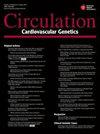Effect of Metformin on Metabolites and Relation With Myocardial Infarct Size and Left Ventricular Ejection Fraction After Myocardial Infarction
Q Medicine
引用次数: 16
Abstract
Background— Left ventricular ejection fraction (LVEF) and infarct size (ISZ) are key predictors of long-term survival after myocardial infarction (MI). However, little is known about the biochemical pathways driving LV dysfunction after MI. To identify novel biomarkers predicting post-MI LVEF and ISZ, we performed metabolic profiling in the GIPS-III randomized clinical trial (Glycometabolic Intervention as Adjunct to Primary Percutaneous Intervention in ST Elevation Myocardial Infarction). We also investigated the metabolic footprint of metformin, a drug associated with improved post-MI LV function in experimental studies. Methods and Results— Participants were patients with ST-segment–elevated MI who were randomly assigned to receive metformin or placebo for 4 months. Blood samples were obtained on admission, 24 hours post-MI, and 4 months post-MI. A total of 233 metabolite measures were quantified using nuclear magnetic resonance spectrometry. LVEF and ISZ were assessed 4 months post-MI. Twenty-four hours post-MI measurements of high-density lipoprotein (HDL) triglycerides (HDL-TG) predicted LVEF (&bgr;=1.90 [95% confidence interval (CI), 0.82 to 2.98]; P=6.4×10−4) and ISZ (&bgr;=−0.41 [95% CI, −0.60 to −0.21]; P=3.2×10−5). In addition, 24 hours post-MI measurements of medium HDL-TG (&bgr;=−0.40 [95% CI, −0.60 to −0.20]; P=6.4×2×10−5), small HDL-TG (&bgr;=−0.34 [95% CI, −0.53 to −0.14]; P=7.3×10−4), and the triglyceride content of very large HDL (&bgr;=−0.38 [95% CI, −0.58 to −0.18]; P=2.7×10−4) were associated with ISZ. After the 4-month treatment, the phospholipid content of very large HDL was lower in metformin than in placebo-treated patients (28.89% versus 38.79%; P=7.5×10−5); alanine levels were higher in the metformin group (0.46 versus 0.44 mmol/L; P=2.4×10−4). Conclusions— HDL triglyceride concentrations predict post-MI LVEF and ISZ. Metformin increases alanine levels and reduces the phospholipid content in very large HDL particles. Clinical Trial Registration— URL: https://clinicaltrials.gov/ct2/show/NCT01217307. Unique Identifier: NCT01217307.二甲双胍对代谢产物的影响及其与心肌梗死后心肌梗死大小和左室射血分数的关系
背景——左心室射血分数(LVEF)和梗死面积(ISZ)是心肌梗死(MI)后长期生存的关键预测因素。然而,对MI后驱动左心室功能障碍的生化途径知之甚少。为了确定预测MI后LVEF和ISZ的新生物标志物,我们在GIPS-III随机临床试验中进行了代谢分析(糖代谢干预作为ST段抬高型心肌梗死初级经皮干预的辅助措施)。我们还在实验研究中研究了二甲双胍的代谢足迹,二甲双胍是一种与改善心肌梗死后左心室功能相关的药物。方法和结果——参与者是ST段抬高型心肌梗死患者,他们被随机分配接受二甲双胍或安慰剂治疗4个月。入院时、MI后24小时和MI后4个月采集血样。使用核磁共振光谱法对总共233个代谢物测量值进行了量化。MI后4个月评估LVEF和ISZ。MI后24小时测量高密度脂蛋白(HDL)甘油三酯(HDL-TG)预测LVEF(&bgr;=1.90[95%置信区间(CI),0.82至2.98];P=6.4×10−4)和ISZ(&bgr;=−0.41[95%CI,−0.60至−0.21];P=3.2×10−5),并且非常大的HDL的甘油三酯含量(&bgr;=−0.38[95%CI,−0.58至−0.18];P=2.7×10−4)与ISZ有关。在4个月的治疗后,二甲双胍组的大HDL磷脂含量低于安慰剂组(28.89%对38.79%;P=7.5×10−5);二甲双胍组丙氨酸水平较高(0.46对0.44 mmol/L;P=2.4×10−4)。结论:HDL甘油三酯浓度可预测MI后LVEF和ISZ。二甲双胍可提高丙氨酸水平并降低非常大的HDL颗粒中的磷脂含量。临床试验注册--URL:https://clinicaltrials.gov/ct2/show/NCT01217307.唯一标识符:NCT01217307。
本文章由计算机程序翻译,如有差异,请以英文原文为准。
求助全文
约1分钟内获得全文
求助全文
来源期刊

Circulation-Cardiovascular Genetics
CARDIAC & CARDIOVASCULAR SYSTEMS-GENETICS & HEREDITY
CiteScore
3.95
自引率
0.00%
发文量
0
期刊介绍:
Circulation: Genomic and Precision Medicine considers all types of original research articles, including studies conducted in human subjects, laboratory animals, in vitro, and in silico. Articles may include investigations of: clinical genetics as applied to the diagnosis and management of monogenic or oligogenic cardiovascular disorders; the molecular basis of complex cardiovascular disorders, including genome-wide association studies, exome and genome sequencing-based association studies, coding variant association studies, genetic linkage studies, epigenomics, transcriptomics, proteomics, metabolomics, and metagenomics; integration of electronic health record data or patient-generated data with any of the aforementioned approaches, including phenome-wide association studies, or with environmental or lifestyle factors; pharmacogenomics; regulation of gene expression; gene therapy and therapeutic genomic editing; systems biology approaches to the diagnosis and management of cardiovascular disorders; novel methods to perform any of the aforementioned studies; and novel applications of precision medicine. Above all, we seek studies with relevance to human cardiovascular biology and disease. Manuscripts are examined by the editorial staff and usually evaluated by expert reviewers assigned by the editors. Both clinical and basic articles will also be subject to statistical review, when appropriate. Provisional or final acceptance is based on originality, scientific content, and topical balance of the journal. Decisions are communicated by email, generally within six weeks. The editors will not discuss a decision about a manuscript over the phone. All rebuttals must be submitted in writing to the editorial office.
 求助内容:
求助内容: 应助结果提醒方式:
应助结果提醒方式:


